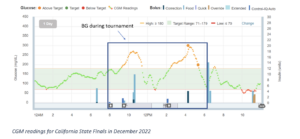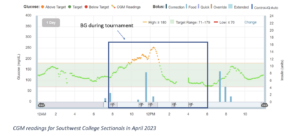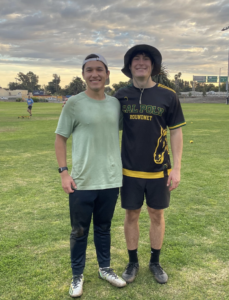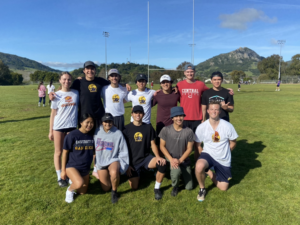
What Is Spikeball?
Have you heard of the popular backyard/beach game called Spikeball? It’s a sport similar to volleyball, where two teams of two players face off against each other with a round net in the middle. A player starts a point by serving the ball down onto the Spikeball net so it ricochets up at his/her opponents. The returning team has up to three hits between them (think bump, set, spike) to return the ball back onto the net. The rally continues until a team can’t return the ball onto the net within their three touches.
Diving Into Competitive Spikeball
In addition to being a recreational backyard game, Spikeball has a competitive side, which I became a part of two years ago when I joined the UC San Diego TritonSpike club. What started out as a fun way to exercise and meet friends at college turned into an opportunity to represent UC San Diego across tournaments all over California. In December 2022, I qualified to play in the top division (Expert) in California when my partner and I took home 1st place in the Contender Division of the California State Finals, making me the first type 1 diabetic to reach this milestone. The only problem: type 1 diabetes.
The Wild Card of Diabetes
I was diagnosed at 13 months old, and even as a lifelong diabetic, I was still pretty bad at managing my glucose when exercising. Even though I am on a Dexcom CGM and Tandem pump with Control-IQ technology, when I played in my first 10-hour Spikeball tournament, my CGM graph looked like a sine wave, going extremely low and then overcorrecting and going high multiple times in the day. Let’s just say I didn’t perform my best during that tournament.
Unfortunately, Spikeball is a sport where diving is involved, so wearing an insulin pump while playing was not an option. Even with Exercise Mode on my insulin pump, I was still going low during both practices and tournaments, so I tried compensating by eating and not blousing before playing, but that just introduced extra factors that made it even more difficult to manage my glucose.
Dr. Edelman’s Advice
I told Dr. Edelman about my problem, and he suggested that I start my Exercise Mode an hour before playing Spikeball. I thought that wouldn’t help and Dr. Edelman was full of baloney, but I decided to try it out, and it actually worked; I had stable glucose readings during 2–4-hour practice sessions. I will never question Dr. Edelman’s expertise again!
The Learning Curve of Playing without My Pump
Although this method works for shorter periods of 2-4 hours when I don’t need to wear an insulin pump, there were some pitfalls when I wasn’t wearing my pump for over five hours of playing. Even though my partner and I won the California State Finals, this was a learning moment as my blood glucose was all over the place, going high and low throughout the day. I even had to take a 15-minute medical break to treat a low during the middle of a game. Not fun.

Controlling Blood Sugar During Tournaments
Playing in so many tournaments, I knew I had to find a way to control my BG so it wouldn’t affect my performance in the game. I thought that if I took Dr. Edelman’s advice and started Exercise Mode 1 hour before the tournament, it would solve the first 2-4 hours of playing like it did for practices. But when lunchtime came around at noon, I decided to do about a 60-70% bolus of what I normally would bolus when eating lunch. This is because Dr. Edelman told me that having a large amount of insulin in my body while exercising would cause my BG to drop very quickly, so to counter dropping, I would inject myself with less insulin than normal. After all, I can play if I’m a little high, but not if I’m too low.
Tweaking My Game Plan
In April 2023, I competed in my last collegiate tournament (Southwest College Sectionals) alongside my friends and teammates representing UC San Diego. I’m glad to say that this tournament was probably the most successful I’ve been in keeping my blood glucose in range for this 10-hour tournament. Although I went high early in the day, I realized that small insulin doses every few hours are necessary to keep my BG within range while also not causing my BG to drop very quickly. With the 60-70% bolus for lunch, you can see my numbers went within range and stayed there for the remainder of the day.

Looking Ahead
Through all of the tournaments that I’ve competed in across California over the past two years, I am still learning how to best manage my diabetes but am steadily improving every tournament (at both Spikeball and diabetes). As the first type 1 diabetic Expert Spikeball player, I am grateful for the opportunity to represent both the diabetes and Spikeball communities. Though juice breaks and fruit gummies mid-tournament may slow me down, I am glad that I am able to perform at this high level of competition while having type 1 diabetes. In the upcoming year, I hope to be playing in a few tournaments at the top division across California, and in the future, hope to play at tournaments across the U.S. If you are a type 1 interested in playing Spikeball, my advice to you is to use Exercise Mode an hour before playing, check your glucose after every game, and don’t let diabetes slow you down! Keep learning and growing as I am, and don’t let diabetes discourage you. You got this!
Watch spikeball in action!

My partner (Jake Woolley, right) and I (left) at the California State Finals tournament

UCSD TritonSpike Club


Leave a Reply